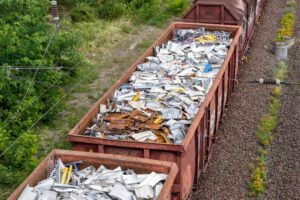Water is the foundation of life, yet it is increasingly under threat. More than two billion people live in countries experiencing high water stress, and the ripple effects extend far beyond human consumption. Water scarcity is not just a humanitarian crisis—it is an ecological one, undermining biodiversity, destabilizing ecosystems, and straining the natural systems that sustain us all.
This article explores the often-overlooked environmental costs of water scarcity and highlights strategies to mitigate them through sustainable water management and circular practices.
What Is Water Scarcity?
Water scarcity arises when water demand exceeds available resources or when poor management degrades supply. It is not only about how much water exists, but also about its quality, accessibility, and resilience over time. Factors include:
- Natural stressors such as arid climates and drought cycles.
- Human-driven pressures such as over-extraction, pollution, and inefficient infrastructure.
- Climate change, which amplifies extremes by making droughts longer and floods more intense.
Ultimately, scarcity reflects not just nature’s limits but how we manage—or mismanage—our relationship with this finite resource.
Environmental Impacts of Water Scarcity
Biodiversity Loss
Freshwater ecosystems—rivers, wetlands, lakes—are among the most threatened habitats on Earth. When flows decline or dry up, fish species vanish, bird migrations are disrupted, and amphibians lose critical breeding grounds. The collapse of one species often cascades through the food web, weakening entire ecosystems.
Ecosystem Disruption
Wetlands, often called the “kidneys of the planet,” filter pollutants, regulate floods, and store carbon. When they shrink due to water scarcity, these natural services are lost. Similarly, reduced river flows alter sediment transport, erode banks, and diminish soil fertility downstream, leaving landscapes less resilient.
Freshwater Depletion
Scarcity drives unsustainable withdrawals from rivers and aquifers. Groundwater in regions like California’s Central Valley and northern India is being pumped far faster than it can be replenished. The result is land subsidence, saltwater intrusion, and long-term collapse of freshwater reserves, further locking communities into crisis.
Strategies for a Resilient Water Future
Improve Water Efficiency
- Agriculture: Transition to drip irrigation, soil moisture monitoring, and regenerative farming that builds soil’s water-holding capacity.
- Cities: Install water-saving fixtures, capture rainwater, and reduce leaks in municipal systems.
- Industry: Redesign production to reuse water internally—closed-loop cooling systems and water recycling reduce strain on local supplies.
Invest in Smarter Infrastructure
- Modernize aging pipes and treatment facilities to reduce waste.
- Expand wastewater recycling and desalination (where energy use is balanced with renewables).
- Restore natural infrastructure: recharging aquifers through wetlands and floodplain restoration is often more effective than building new dams.
Embrace Sustainable Water Management
- Implement integrated water resources management (IWRM) that balances agricultural, industrial, and ecological needs.
- Align pricing policies to reflect water’s true value—encouraging efficiency while protecting access for vulnerable communities.
- Protect watersheds and forests, which naturally regulate flows and filter pollutants.
Circular Economy Approaches
- Shift from linear “use-and-dispose” water systems to circular models where reuse, recycling, and regeneration are standard.
- Encourage businesses to design supply chains with water stewardship at the center, from textile dyeing to food production.
- Support community-level innovations like decentralized greywater reuse and local rainwater harvesting.
Final Thoughts
The hidden costs of water scarcity extend well beyond empty taps. Biodiversity collapse, ecosystem disruption, and depleted freshwater reserves threaten both planetary and human health. Yet solutions exist: from precision agriculture to watershed restoration, from circular water systems to policy reforms that treat water as the shared resource it truly is.
Mitigating water scarcity is not only about securing drinking water—it’s about safeguarding the living systems that make life possible. By acting now, we can create a resilient water future that sustains people, economies, and the planet itself.









Reader Interactions